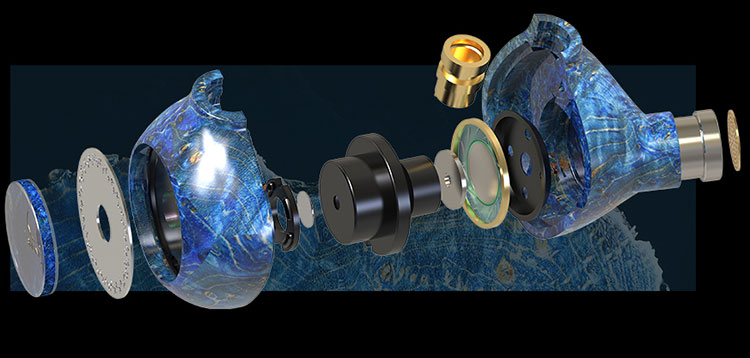In this feature, we review the new Shanling MG600 which is a universal single dynamic driver IEM with a semi-open acoustic design. It is priced from $599.
Disclaimer: This is a sample sent to us in exchange for our honest opinion. Headfonics is an independent website with no affiliate links or status. We thank Shanling for this opportunity.
To find out more about Shanling products we have previously featured on Headfonics click here.
Note, that this article follows our latest scoring guidelines which you can read up on here.
At the same time when the M7 DAP was announced, Shanling also released the MG600, an open-back IEM with a fully stabilized wood body that is rather uncommon for its price range.
Denoted by the label G, Shanling hopes to bring back the golden times of dynamic IEMs, blending together new driver membrane material designs and some unusual effort in acoustics and aesthetics.
So far, this is the most luxurious-looking Shanling IEM with a unique design that is significantly differentiated from the competition, so let’s see how it sounds!

Tech Highlights
The Shanling MG600 has adopted an unusual design with wooden elements in and out. On the faceplate, there is a sunken rim and a circular filtering plate with techno patterns that are designed to balance the pressure on both sides of the driver when worn and to enhance dynamics.
The MG600 uses N48 Neodymium magnets, a proprietary 10mm carbon composite dynamic driver that mixes together carbon fiber, graphite, and Mica fragments, then injected into the mold to become a dense yet elastic compound.
The central dome piece of the membrane uses magnesium alloy to enhance clarity and press down unwanted distortion. The enameled coil inside uses cores from Daikoku Japan which is known for its reliability and reduces distortion at the same time.
Design
The internals is very special for this IEM yet the exterior design is even more eye-catching. The sound chamber is built from stabilized Maple wood, so on every piece of MG600, there is a unique pattern.
On the centerpiece Shanling’s logo sits smartly on top and on the sides, you will find an MMCX socket that allows users to swap to other cables. The MG600 has a metallic nozzle that complements the metallic grill filter on top.
The stabilized wood material is made by infusing resins into the wood and filling up its gaps, achieving a colorful pattern and denser combination of material that is then used as the sound chamber for the design. Looking closely, you can see how the front and back chambers are fitted seamlessly together.
On the faceplate, an area is carved out to expose the circular filtering layer, which has shapes like water break stones punched on top, similar to brake pads on sports cars.
The semi-open-back design is intended to enhance the bass frequencies by regulating the air pressure. And when you flip to the other side, you can see a metallic nozzle
Comfort & Isolation
Measuring just 3.3g per side, the MG600 is incredibly light despite of its solid appearance. The size of the enclosure is quite small with a moderately deep insertion depth, so it fits very firmly on the ear, especially when using the SpinFit tips provided. I
t is easy to get a good fit at different angles, and the almost weightless body can sit in the ear comfortably for hours.
As for isolation, I would consider it 40% weaker than average closed-back IEMs. Yet the design is helping the MG600 to sound a lot more open, and it is great for those who don’t want to be completely blocked from the ambiance when listening to music.
Tips
The package comes with a generous selection of tips which has different bore sizes, the tips are tuned for bass-optimized, balanced, enhanced staging performances. In addition, there is a pack of SpinFit ear tips provided.
With tips that press down the mid-bass, the staging feels more opened up and the midrange sounds even smoother but may be slightly hollowed out the vocal. Make sure to get a good seal and the bass will be delivered firmer and airier.
Stock Cable
If you have read our ME800 review you may remember the same cable being used on this flagship hybrid IEM from Shanling.
The MG600 uses exactly the same cable with a swappable connector system that is very well designed for hot plugging, it won’t take more than 10 seconds to switch between 2.5 / 3.5 / 4.4mm connections and the construction is solid.
Back to the MMCX terminated stock cable, the cores use 8*18 strands of cores which include 6 x single crystal copper and 2 x SPC.
Interestingly there are 2 separate layers inside and the outer layer is shielded to reduce EMF. The overall build quality is excellent though I would suggest not to always switch between different connectors or else it may be loosened.
Packaging & Accessories
We have tested many Shanling products and all of them have packaging that is artistically designed, with well-chosen paper materials and a delightful open box experience. MG600 is no exception but this time it comes with a very different blue theme that is more playful.
Digging inside the packaging, the earphones are displayed on the first layer, and in the lower layer, you will find the many sets of tips as well as the swappable plugs towards the source end.
There is also a PU leather case supplied that is of very high quality and feels premium to the touch.
Sound Impressions
The below impression is given using the balance tuning tips which I think sound most natural, and the MG600 is burnt in for more than 100 hours.
Summary
This is the first time I listen to a semi-open-back design with stabilized wood housing, especially with a single dynamic driver that uses the housing as a part of its resonance design.
I was expecting thinner lows and more protruded highs, yet Shanling does a great job keeping the lower frequencies firm and dense while maintaining decent resolution and treble presence without bringing up any unwanted sibilance.
I would classify the MG600 as being slightly V-shaped in tuning, but not overly uncolored with most pairings. It also requires plenty of current to drive it to its full potential.
The smooth, well-articulated mid-range is naturally rendered and forgiving with lower resolution music. While the fast response enabled by the carbon composite driver membrane helps to boost the transient performance in the highs, putting together a spacious and resolving output.
Bass
The MG600 adopts a semi-open-back dynamic design on stabilized wood housing, which is not as dense as metallic housing. With wooden filters, it is rendering the bass in an effortless, airy manner, and is free from being very colored or loose in definition which is what I have expected.
When plugged into a good source such as the Shanling M7, there is some good power. The MG600 has a speedy punch with plenty of energy also. As expected with the impression given by the wooden material and rigid driver membrane, the MG600 attacks quite fast and decays in a slightly soft manner.
Testing with electro house music, the bass is expansive and able to fill up the space rendered with good power also without bleeding into the mid-bass frequencies. There is a good sense of control and the MG600 present synthesized bass smooth and explicitly.
Other bass instruments such as the bass guitar can be well heard and are well complemented by the energy and clarity in the treble, though not very thick in the body. I find the tuning ideal for fast, uplifting beats, symphonic metal, and instrumentals.
When listening outdoor I would prefer either the bass tips or the balance tips, which will give the low end more power and richness to compensate for the ambient noise leaking through.
Mids
The mid-range on the MG600 is not as intense as the lower end and is smoothly articulated to sound spacious and clean in tone. For dark or deep voices, the energy carries through the bass to the mid-lows to sound powerful and not lack in weight.
Testing with Johnny Cash’s “I Walk the Line” which I sometimes use to check how the IEMs handle thicker voices, the vocal body sounds moderately textured and is relaxing and spaced from the listener.
There is a small hint of warmth that comes from the lower end which adds to the body of the vocal or instruments like the guitar and to compensate for the mid-treble range that is pronounced.
Warmer, thicker DAPs would be a more ideal pairing for vocal works but for instrumentals, a clean and powerful source will sound more expansive and balanced with the MG600.
The MG600 sounds quite unaltered in the midrange and works pretty well with Jazz due to its speed attack and strong dynamics, and the vocal line is swiftly presented with decent separation.
With various pairings, the mids sound less intense than the lows and treble, which favors pop, R&B, and electronic music that stresses the rhythm. A good balance is achieved to not hollow out the midrange but to stretch the perceived staging and enhance airiness.
Treble
Treble on the MG600 sounds quite firm but is free from top-end shimmer. Violins and other woodwind instruments penetrate through mid-air with good intensity but the edges are softly taken away to make it sound very comfortable.
Testing with La Traviata’s “Libiamo, ne’ lieti calici”, the soprano vocals are cleanly presented with decent power and air in the top end, and harmonics are well present but not overly strengthened.
The tuning gently smooths out sharp overtones and takes care of harshness beautifully while the treble is quite forwarded and rounded. Such shifts the attention more to the vocals and instruments in the lower register and I am preferring to push the edges a bit for clarity by using higher gain.
Staging
The MG600 scales with powerful outputs to sound well stretched in instrument separation. Staging is moderately expanded and is well extended in the y axis. Even when it is an open-back design the reverbs and harmonics are clearly captured, and the headroom rendered is similar to listening in a huge arena.
When listening to Beethoven’s Symphony no. 9 performed by the Chicago Symphony Orchestra on the M7, the MG600 is able to capture the deep and expansive bass dynamically, although the mid-range is very smooth, instruments are still clearly defined and spaciously separated in between.
Testing with more genres of music, the elevation on the two ends enhances the presence of instruments and their overtones, stressing the dynamics. When powered by a warmer source the bass would sound even more expansive and favor synthesized bass instruments.
The vocal image, on the other hand, is distinct in positioning and well separated, but again, requires a thicker source for more presence.









